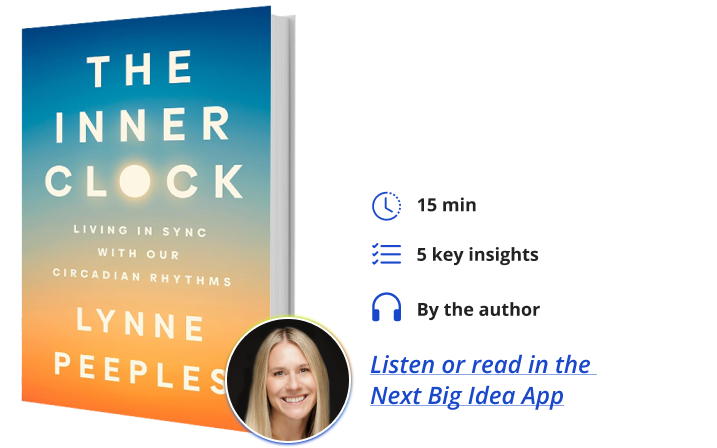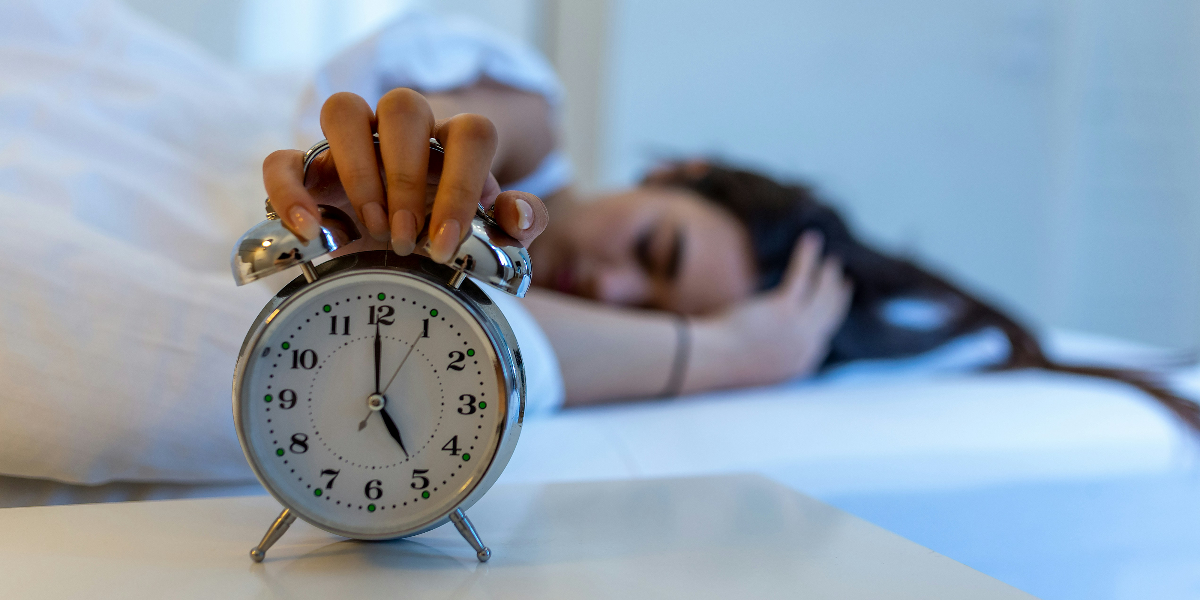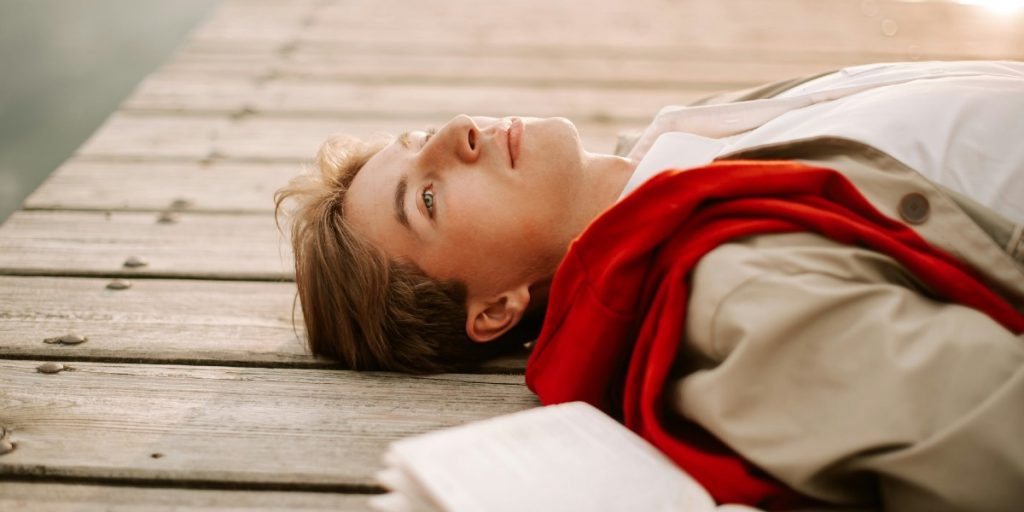Lynne Peeples started her career as a biostatistician before shifting to science journalism. Her writing has appeared in The Guardian, Scientific American, Nature, and other publications.
What’s the big idea?
The human body is intricately synchronized to the sun and environmental signals so that it can calibrate its internal clocks. Unfortunately, modern insults like artificial light, contrived time zones, and late-night snacking wreak havoc on our circadian rhythms.
Armed with advances in biology and technology, a circadian renaissance is reclaiming those lost rhythms. Journalist Lynne Peeples explores the transformative applications of this emerging science so that we can keep our bodies healthier, minds sharper, and moods brighter.
Below, Lynne shares five key insights from her new book, The Inner Clock: Living in Sync with Our Circadian Rhythms. Listen to the audio version—read by Lynne herself—in the Next Big Idea App.

1. You contain trillions of tiny timekeepers.
You’ve got clocks in your brain, bowels, nose, and toes. These evolved to tick in coordination with each other—and in harmony with Nature’s rhythms—to regulate countless physiological processes that make everyday life possible.
Biological clocks go back to primordial time. Nearly all living things on Earth emerged under inescapable daily, lunar, seasonal, and annual cycles, the most notable of which was the rising and setting sun. Because survival meant embracing and exploiting the planet’s predictable patterns, organisms developed internal clocks that could generate regular rhythms to match. That original biotech gave life the capacity to prepare for coming changes rather than react. A symphony of inner clocks improved the chances of doing the right things at the right times.
For example, it was probably imperative for our ancestors to sleep during the hours of darkness and to maximize strength and speed around sunset, perhaps when hauling home the yields of a hunt while being chased by a bear. It was also best for their bodies to pump out digestive juices when that food was most likely to be ingested and to fortify protective barriers when ultraviolet light or pathogens were most threatening. The human body simply can’t be primed to do all the things at all the times. Inner clocks proved valuable time managers. And that remains true today.
Imagine you fly from New York City to Honolulu, land at 2 p.m., and head straight to the beach. Your circadian clocks are still ticking on New York City time as if it was 8 p.m. By that hour, your body’s defense force will have let down its guard, leaving your skin more susceptible to sunburn. By the end of the vacation, your clocks will be more closely aligned with Honolulu time. This is because our circadian clocks are not precision timepieces. They naturally run a little faster or a little slower than the time it takes the Earth to spin. So, your clocks are constantly looking for clues, like the alternation of light and dark as our planet pirouettes, to calibrate to the local 24-hour day. Still, they evolved to adjust by only small increments each day. This is why we suffer jet lag when we cross multiple time zones. It’s also why we don’t need to be jetsetters to wreck our clocks.
2. Modern society has made it hard for circadian clocks to keep time.
While day and night were clearly delineated for our ancestors, the boundaries are blurred for modern humans. We spend most hours indoors. We use bright lights at night. We work shift schedules. We observe daylight saving time. We start school too early. We eat too late at night. The list goes on. Without regular day-and-night cues, our circadian clocks can fall out of sync. This can interfere with sleep, diminish productivity, and raise the risk of chronic diseases. Scientists now link disrupted circadian rhythms with many health issues, including depression, diabetes, and dementia.
These clock troubles may start early in life. A pregnant woman relays time-of-day signals to her fetus through the ebb and flow of body temperature and changes in circulating hormones and nutrients. Even photons of light may penetrate the womb. But if a mother’s rhythms are out of sync, her baby will struggle to catch the beat. Even after birth, a baby still counts on supplemental circadian cues from its parents to keep rhythm.
“Scientists now link disrupted circadian rhythms with many health issues, including depression, diabetes, and dementia.”
One easily overlooked source of such information is breast milk. The ingredients of a mother’s milk are very different at eight in the morning compared to eight at night. Morning milk contains more of the alerting hormone cortisol. Night milk contains more sleep-promoting melatonin. Sharing these timely hormones supports a baby’s daily rhythms. But only when the mother shares them at the right times. Breast milk pumped in the morning and bottle-fed to a baby in the evening may be counterproductive, making sleep extra hard both for the baby and its parents.
3. We can reinfuse lost circadian cues.
Fortunately, simple fixes can reset our clocks and reclaim our lost rhythms. I recommend three core clock rules:
Contrast. Brighten your days and darken your nights. Get outside in the morning and as often as possible throughout the day for additional doses of daylight. Sit or stand close to a window while you work. When necessary, supplement natural light with artificial light that closely mimics the sun’s midday rays—bright and rich in blue wavelengths. At night, dim your lights. Try warm tabletop lamps or candles. You might even spread out a sea of faux candles, as I’ve done in my apartment, and light them with a click of a remote. Finally, as you’ve been repeatedly told, limit your screen time.
Constrict. It’s not just what you eat but when you eat that matters. We should only eat when the body is ready to handle the incoming calories, generally during daylight hours. So, tighten your meal window during the day. Consider holding off for an hour or two after you wake up. Then stop eating at least three hours before you go to bed—that means not a sip of wine or even warm milk.
Consistent. Eat, exercise, and sleep at the same hours seven days a week. Recent research hints that sleep timing may be more important than duration for our health. Of course, modern society’s rigid—and often biologically backward—schedules make it difficult to sleep and wake by the body clock daily. Again, there are practical remedies. We could collectively agree to delay school bells and flex working hours to allow people to wake up without alarm clocks.
4. Circadian awareness can enhance performance, productivity, and medicine.
Your brain and body at noon are not the same as your brain and body at midnight. You might want to set your expectations and your schedule accordingly. When do you feel the most focused, happiest, strongest? Like me, you may feel most optimistic a couple of hours after waking up. Maybe you lose all motivation to do anything but nap in the mid-afternoon. And maybe your legs feel like lead during a morning run, yet like a cheetah’s in the evening. Whatever your personal highs and lows, you can thank your circadian rhythms. Then, with this awareness, you can harness them.
Try organizing your day around your peaks and troughs. Personally, I do my important thinking and writing early in the day. I more-or-less write off mid-afternoons for mostly brainless stuff, like dusting my apartment or cleaning out my inbox. But maybe you have no choice. Maybe that’s when you’re scheduled to give an important speech or interview. Or maybe you’re a musician or a comedian set to take the stage, or an athlete about to take the court or field. For the average athlete, performance peaks in the late afternoon or early evening. In other words, if a Boston team flies into Seattle for a 1 p.m. kickoff or first pitch, they would have the circadian edge.
“Try organizing your day around your peaks and troughs.
Athletes, coaches, CEOs, and military leaders are among those recognizing the profound implications. Meanwhile, scientists are developing novel tools to manipulate our clocks—to either get them back in sync faster or trick them into thinking the local time is earlier or later than it really is. Both could help tee anyone up for greater success and better health. Researchers are testing flashes of light while we sleep, glasses that beam blue light into our eyes, and even drugs that directly alter our clockwork. Similar efforts are underway in medicine, as experts recognize that the time of day a drug or other treatment is delivered could meaningfully alter its effectiveness and side effects.
5. Circadian science for sustainability.
The first recorded evidence of a living timekeeper came from a plant. Centuries later, scientists are looking to plant clocks with the goal of adding years of livability.
Inner clocks control nearly every aspect of a plant’s physiology, including how readily it takes in sunlight, water, nutrients, and chemicals. Researchers have shown, for example, that Roundup is more effective at killing weeds at certain times of day. Strategically timing inputs or genetically tweaking a plant’s circadian clocks could result in greater yields while using fewer toxic chemicals and less water. It could bolster a crop’s resistance to extreme conditions. It could increase the contents of protein, vitamins, and phytochemicals. It could even make a crop last longer.
Plant clocks can keep ticking after harvest. However, we often unintentionally quiet those clocks, much like we do our own. In so doing, we waste precious food. Carrots and cabbage may sit under constant bright light in a 24-hour supermarket. Then they might land in a perpetually dark refrigerator drawer, with only brief blasts of light every time its buyer goes in search of a snack. At least one fridge company is attempting to extend freshness with cycled LED lights.
While far less ideal than sustaining life on planet Earth, circadian science may prove helpful if we ever need to transplant people, plants, and other organisms to another planet. Mars is the leading contender. Among the daunting challenges we would face are different day lengths and wavelengths of light. We’d see a whole lot more red than blue on Mars. Personally, I prefer blue. Our circadian clocks do, too.
To listen to the audio version read by author Lynne Peeples, download the Next Big Idea App today:
































